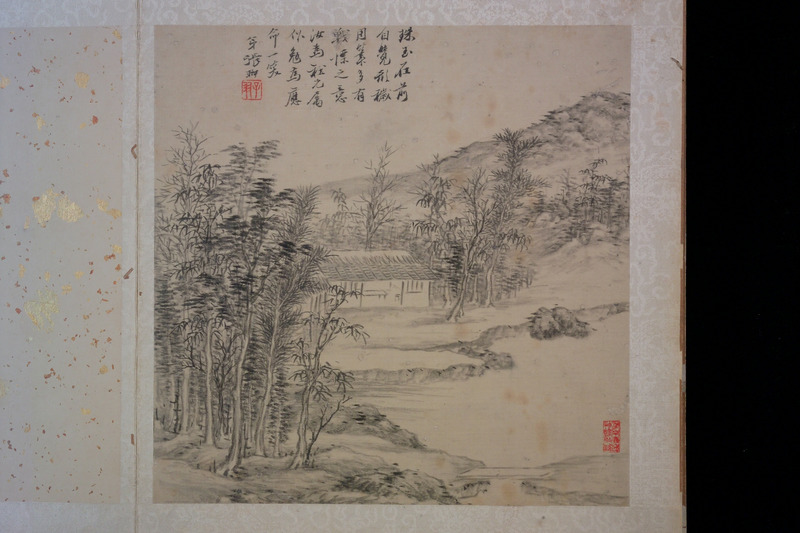Ming Dynasty Paintings Ming Dynasty Easy Art
The Collection of Landscape Paintings consists of ten masterpieces, all of which are the small size ink-wash landscape paintings by famous painters of the late Ming Dynasty and early Qing Dynasty. Five masterpieces are selected for the reader's appreciation.










The first one is a landscape entitled "Bamboos and Stones" by the master Lan Ying. Length: 27.2cm; width: 25.8cm. Material: damask.
Lan Ying (1585 - 1664) was born in Qiantang (nowadays: Hangzhou, Zhejiang province). His style name is Tian Shu and his pseudonym is Die Sou. He was a Chinese painter of landscapes, human figures, flowers and birds who was active during the late Ming Dynasty
The painter employs the hard-dry stroke technique (a technique used in Chinese landscape paintings to represent the texture of the stones and hills) to depict the lake stone, branches of the pine trees and the dry wood. The whole picture is painted with light ink, except the bamboos, presenting some fresh and invigorating visual effects. It can be concluded from the inscription that this painting is an imitation of another painter Ni Zan (1301-1374, a painter of Yuan Dynasty). Therefore it boasts of some features of the landscape paintings of Yuan Dynasty: a sense of detachment from the worldly matters.
The second one is a landscape entitled "Mountains and Streams" by the master Sun Yi. Length: 26cm; width: 24.8cm. Material: paper.
Sun Yi (? - 1658) was born at Haiyang (some people say that he was born at Huizhou). His style name is Wu Yi and his pseudonym is Shu Lin.
High mountains are depicted in the picture, and two imposing rocks stand on the two sides of the stream, which runs through the hills. Over the stream stretches a wooden bridge with a small pavilion on it. Thin ink is used to depict the mountains and rocks while thick ink is used to represent the grass (this is a technique used in Chinese landscape paintings to represent the moss or the small trees over the top of the mountains). The brushwork is of great simplicity, which demonstrates the painter's simple wish of leading a hermit's life in a cottage in the mountains.
The third one is a landscape entitled "Yunshanxiao Buddhist Temple" by the master Zheng Yuanxun. Length: 27.5cm; width: 26cm. Material: damask.
Zheng Yuanxun (1604 - 1645) was born at Mingshe County (nowadays in Anhui province). His style name is Chao Zong and his pseudonym is Hui Dong.
There are many impressive elements in the picture, including the steep mountains, high peaks, gathering clouds, and a Buddhist temple at the valley. The mountains are covered with grass and woods. There are a few old trees, standing on the rocks with the branches painted with thick ink.
The fourth one is a landscape entitled "Old Woods and Pine Trees" by the master Fang Yizhi. Length: 26.8cm; width: 26cm. Material: damask.
Fang Yizhi (1611 - 1671) was born in Tongcheng, Anhui province. His style name is Mi Zhi and his pseudonym is Man Gong.
The picture boasts of the painting features of Yuan Dynasty, representing a view of the countryside and the mountainous village, with several trees standing upward, covered with few leaves. Under the tree erects a cottage. In the distance, the mountains and rocks are barely visible, which represents the bleakness of the view. What's more, it can be concluded that after the fall of Ming Dynasty, the painter was very sad and wanted to lead a hermit's life. It can be seen that the painter imitates the brushwork of Ni Zan (1301-1374, a painter of Yuan Dynasty), with great simplicity.
The fifth one is a landscape entitled "The Reclusive Life upon the Quiet Lake" by the master Weng Ling. Length: 26cm; width: 26cm. Material: damask.
Weng Ling (dates unknown) was born at Jianning, Fujian province of Qing Dynasty. His style name is Shou Ru and his pseudonym is Leishi Shanqiao.
With simple brushwork, this is an imitation of Ni Zan (1301-1374, a painter and poet of Yuan Dynasty). Several trees grow on the small mounds. Behind the trees is a thatched pavilion. A lake with still water is represented and the distant mountains are barely visible as they are shrouded in mist. The simple brushwork is of great beauty and the structural arrangement is of great naturalness. Ink is the dominant color and some light colors are also applied.
深入探索
Ming Dynasty painting
During the Ming Dynasty (1368-1644), Chinese painting developed greatly from the achievements in painted art during the earlier Song Dynasty and Yuan Dynasty. The painting techniques which were invented and developed before the Ming period became classical during this period. More colours were used in painting during the Ming Dynasty. Seal brown became much more widely used, and even over-used during this period. Many new painting skills/techniques were innovated and developed; calligraphy was much more closely and perfectly combined with the art of painting. Chinese painting reached another climax in the mid-, late- Ming Dynasty. The painting was derived in a broad scale, many new schools were born, and many outstanding masters emerged.
Source: https://www.hnmuseum.com/en/zuixintuijie/landscape-paintings-ten-masters-end-ming-dynasty
0 Response to "Ming Dynasty Paintings Ming Dynasty Easy Art"
Postar um comentário